SUICIDE BOMBS AND SUICIDE BOMBERS

Poster Glorifying Suicide
Bomber in Jenin The explosives and detonator on suicide bombs are often placed on a belt or vest that is rapped around the torso. A wire connects the detonator and bomb with a cigarette-lighter-size arming device and trigger that is used to detonate the bomb and is hidden the bombers pocket of hand. Sometimes suicide bombers are discovered because of their bulky clothing or heavy coats in hot weather or because their triggering devises are visible of they have their hands suspiciously in their pockets,
Bruce Hoffman wrote in The Atlantic Monthly: “Such are the weapons of war...today: nuts and bolts, screws and ball bearings, any metal shards or odd bits of broken machinery that can be packed together with homemade explosive and then strapped to the body of a terrorist dispatched to any place where people gather — bus, train, restaurant, café, supermarket, shopping mall, street corner, promenade. These attacks probably cost no more than $150 to mount, and they need no escape plan — often the most difficult aspect of a terrorist operation. And they are reliably deadly. According to data from the Rand Corporation's chronology of international terrorism incidents, suicide attacks on average kill four times as many people as other terrorist acts. [Source: Bruce Hoffman, The Atlantic Monthly, June 2003]
“The terrorists are lethally flexible and inventive. A person wearing a bomb is far more dangerous and far more difficult to defend against than a timed device left to explode in a marketplace. This human weapons system can effect last-minute changes based on the ease of approach, the paucity or density of people, and the security measures in evidence. On a Thursday afternoon in March of last year a reportedly smiling, self-satisfied bomber strolled down King George Street, in the heart of Jerusalem, looking for just the right target. He found it in a crowd of shoppers gathered in front of the trendy Aroma Café, near the corner of Agrippas Street. In a fusillade of nails and other bits of metal two victims were killed and fifty-six wounded. Similarly, in April of last year a female suicide bomber tried to enter the Mahane Yehuda open-air market — the fourth woman to make such an attempt in four months — but was deterred by a strong police presence. So she simply walked up to a bus stop packed with shoppers hurrying home before the Sabbath and detonated her explosives, killing six and wounding seventy-three.”
Suicide Bombing Numbers
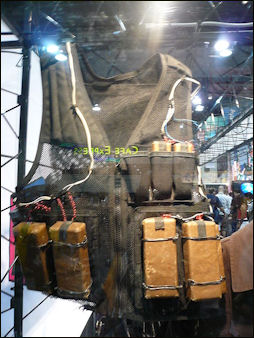
Suicide bomber vest Robin Wright wrote in the Washington Post: “Suicide bombers conducted 658 attacks around the world in 2007, including 542 in U.S.-occupied Afghanistan and Iraq, according to data compiled by U.S. government experts. The large number of attacks — more than double the number in any of the past 25 years .More than four-fifths of the suicide bombings over that period have occurred in the past seven years, the data show. The bombings have spread to dozens of countries on five continents, killed more than 21,350 people and injured about 50,000 since 1983, when a landmark attack blew up the U.S. Embassy in Beirut. [Source: Robin Wright, Washington Post, April 18, 2008]
"Increasingly, we are seeing the globalization of suicide bombs, no longer confined to conflict zones but happening anywhere," said Mohammed Hafez of the Naval Postgraduate School in Monterey, Calif., and author of the book "Suicide Bombers in Iraq." He calls the contemporary perpetrators "martyrs without borders." The unpublished data show that since 1983, bombers in more than 50 groups from Argentina to Algeria, Croatia to China, and India to Indonesia have adapted car bombs to make explosive belts, vests, toys, motorcycles, bikes, boats, backpacks and false-pregnancy stomachs.
Of 1,840 incidents in the past 25 years, more than 86 percent have occurred since 2001, and the highest annual numbers have occurred in the past four years. The data show more than 920 suicide bombings in Iraq and more than 260 in Afghanistan, including some that killed scores of U.S. troops. All occurred after the U.S. invasions of Afghanistan in 2001 and Iraq in 2003. The exact number of U.S. casualties from the bombs in Iraq is classified "because it might show the effectiveness of the enemy's weapon," said Maj. Brad Leighton, a U.S. spokesman in Iraq. "They won't even give the number to me."
More than 3,420 Americans have died in at least 10 major suicide bombing incidents, beginning with the embassy bombing in Beirut, which killed 63 people, including 17 Americans, and injured more than 100. The bombing of the U.S. Marine barracks in Beirut six months later killed 241 and still ranks as the largest loss of American military life in a single incident since the Battle of Iwo Jima in World War II. At least two-thirds of suicide bombings since 1983 have targeted U.S. policy goals, intelligence officials say. "They may be targeting the U.S. but not hitting either the American homeland or American interests in other countries," said Gary LaFree, director of the University of Maryland's National Consortium for the Study of Terrorism and Responses to Terrorism.
Carnage of Suicide Bombing
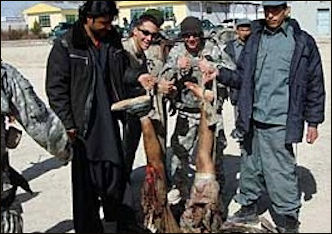
U.S. soldiers and Afghan police
pose with a mangled corpse The bombs generally blow the torso of the bomber to bits but leave the head intact. It is often found somewhere in the vicinity of the blast. When the bomb explodes it often sends the head of the bomber flying and leaves only a leg or two behind. Sometimes the head is found dozens of meters away. Other times it goes flying through a window. Bits of body and flesh are scattered in all directions. Some suicide bombers raise their arms before the bomb exploded so their arms don’t obstruct the flying shrapnel.
Reporting from Hadassah Hospital in Jerusalem, where he was meeting with Dr. Shmuel Shapira, a doctor who often say suicide attack victims, Bruce Hoffman wrote in The Atlantic Monthly: " This is not a place to have a wristwatch,”" he said as he described the injuries of a young girl who'd been on her way to school one morning in November 2002 when a suicide terrorist detonated a bomb on her bus. Eleven of her fellow passengers were killed, and more than fifty others wounded. The blast was so powerful that the hands and case of the bomber's wristwatch had turned into lethal projectiles, lodging in the girl's neck and ripping a major artery. The presence of such foreign objects in the bodies of his patients no longer surprises Shapira. “We have cases with a nail in the neck, or nuts and bolts in the thigh ... a ball bearing in the skull,” he said.” [Source: Bruce Hoffman, The Atlantic Monthly, June 2003]
In Israel, “buses remain among the bombers' preferred targets, Hoffman wrote. “Winter and summer are the better seasons for bombing buses in Jerusalem, because the closed windows (for heat or air-conditioning) intensify the force of the blast, maximizing the bombs' killing potential. As a hail of shrapnel pierces flesh and breaks bones, the shock wave tears lungs and crushes other internal organs. When the bus's fuel tank explodes, a fireball causes burns, and smoke inhalation causes respiratory damage. All this is a significant return on a relatively modest investment. Two or three kilograms of explosive on a bus can kill as many people as twenty to thirty kilograms left on a street or in a mall or a restaurant. But as security on buses has improved, and passengers have become more alert, the bombers have been forced to seek other targets.
In Israel the bodies are cleaned up by the ultra-Orthodox Burial Society who are concerned that every pieces of Jewish flesh is salvaged and given a proper burial. Corpses are put in body bags and smaller body parts are picked up with tweezers and are but in transparent freezer bags by men in sterile body suits. Describing the scene after a suicide bomb attack in Haifa in 2003, John Burns wrote in the New York Times: “Police, and ambulance crews and forensic teams have an unflustered pattern, carrying off the wounded, loading the bodies and body parts into bags, moving about among the pools of blood and wreckage in their white overalls, their rubber gloves, their plastic yellow overshoes...To the rear of the restaurant...the emergency teams placed the head of the suicide bomber on a wooden table.” Israeli experts were called into identify the body parts of the February 2003 Columbia Space Shuttle disaster.
Profile of Suicide Bombers
.jpg)
Suicide bomber stopped in Gaza Most of the September 11 terrorists came from comfortable middle- to upper-middle-class families and were well educated. The Economist reported: The affluence of many of the September 11th hijackers cast doubt on the notion that poverty was a necessary, let alone sufficient, condition for suicidal terrorism. And since the start of the second intifada in 2000, the profile of Palestinian bombers has changed: several have been well educated and less devout than those of the mid-1990s. The LTTE, and especially the PKK and Chechen terrorists, have preferred female bombers, because they attract, or used to attract, less suspicion. Some Palestinian groups (though not al-Qaeda) have also used women, conjuring up fresh religious sophistries to justify female martyrdom. Globally, says Yoram Schweitzer, an expert in suicide terrorism at the Jaffee Centre for Strategic Studies in Tel Aviv, the bomber has no clear profile. [Source: The Economist, January 8, 2004]
In Israel, where suicide attacks peaked in the early 2000s, most suicide bombers have been young men in their teens or 20s, but there have also been some young women, and older men with children. About a third of the bombers have had some university education. Most have been unemployed. Only 13 percent have been married. Most have been religious but have not been regarded as fundamentalists. Their friends often have described them as ordinary guys. About 60 percent have come from the West Bank, 35 percent from the Gaza Strip and 5 percent have been Arabs from Jerusalem or Israel proper.
After discussions with Jerusalem police about suicide bombing, Bruce Hoffman wrote in The Atlantic Monthly: “The early years of suicide terrorism were a simpler time, the officers explained. Suicide bombers were — at least in theory — easier to spot then. They tended to carry their bombs in nylon backpacks or duffel bags rather than in belts or vests concealed beneath their clothing, as they do now. They were also typically male, aged seventeen to twenty-three, and unmarried. Armed with these data, the authorities could simply deny work permits to Palestinians most likely to be suicide bombers, thus restricting their ability to cross the Green Line (Israel's pre-1967 border) into Israel proper from the West Bank or the Gaza Strip. [Source: Bruce Hoffman, The Atlantic Monthly, June 2003]
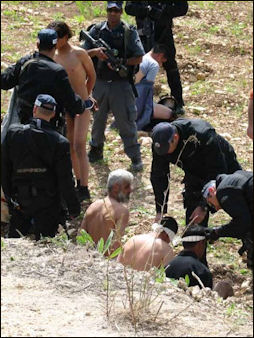
Suicide bombers
caught in Israel By 2003 “though, suicide bombers are middle-aged and young, married and unmarried, and some of them have children. Some of them, too, are women, and word has it that even children are being trained for martyrdom. "There is no clear profile anymore — not for terrorists and especially not for suicide bombers," an exasperated senior officer in the Israel Defense Forces told me last year. Sometimes the bombers disguise themselves: male shaheed (Arabic for "martyrs") have worn green IDF fatigues; have dressed as haredim (ultra-Orthodox Jews), complete with yarmulkes and tzitzit, the fringes that devout Jews display as part of their everyday clothing; or have donned long-haired wigs in an effort to look like hip Israelis rather than threatening Arabs. A few women have tried to camouflage bombs by strapping them to their stomachs to fake pregnancy. And contrary to popular belief, the bombers are not drawn exclusively from the ranks of the poor but have included two sons of millionaires. The Israeli journalist Ronni Shaked, an expert on the Palestinian terrorist group Hamas, who writes for Yedioth Ahronoth, an Israeli daily, has debunked the myth that it is only people with no means of improving their lot in life who turn to suicide terrorism. "All leaders of Hamas," he told me, "are university graduates, some with master's degrees. This is a movement not of poor, miserable people but of highly educated people who are using [the image of] poverty to make the movement more powerful."
Worldwide, Robin Wright wrote in the Washington Post, “Few of the perpetrators have been identified. "We're dependent on the terrorist group to make a public claim or release a martyrdom tape," said Hoffman. "But if the bomber was never fingerprinted or governments do not have their DNA, he or she usually remains anonymous. What makes it so formidable a tactic or strategy is these legions of unknown soldiers deployed against us." [Source: Robin Wright, Washington Post, April 18, 2008]
Suicide Bombing Missions
The Economist reported: “A better way to understand the popularity of suicide attacks may be to focus on their advantages for the groups who commission them. Such operations are rarely, if ever, the work of lone lunatics. Hamas, PIJ and the other Palestinian groups who practise suicide terrorism recruit, indoctrinate and train their bombers. They write the texts for the video testaments filmed shortly before each self-immolation (making them unreliable records of the true motives of the “martyr”), which the bombers themselves watch to redouble their resolve. They take the photographs that will later appear on propaganda posters. Then they deliver their foot-soldiers to pre-identified targets. Al-Qaeda is remarkable for the expertise and independence of its agents, but they too are trained and primed for their missions. [Source: The Economist, January 8, 2004]
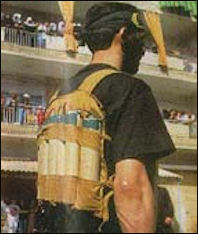
suicide backpack Bruce Hoffman wrote in The Atlantic Monthly: “Suicide bombing initially seemed the desperate act of lone individuals, but it is not undertaken alone. Invariably, a terrorist organization such as Hamas (the Islamic Resistance Movement), the Palestine Islamic Jihad (PIJ), or the al Aqsa Martyrs Brigade has recruited the bomber, conducted reconnaissance, prepared the explosive device, and identified a target — explaining that if it turns out to be guarded or protected, any crowded place nearby will do. "We hardly ever find that the suicide bomber came by himself," a police officer explained to me. "There is always a handler." In fact, in some cases a handler has used a cell phone or other device to trigger the blast from a distance. A policeman told me, "There was one event where a suicide bomber had been told all he had to do was to carry the bomb and plant explosives in a certain place. But the bomb was remote-control detonated." [Source: Bruce Hoffman, The Atlantic Monthly, June 2003]
“The organizations behind the Palestinians' suicide terrorism have numerous components. Quartermasters obtain the explosives and the other materials (nuts, bolts, nails, and the like) that are combined to make a bomb. Now that bomb-making methods have been so widely disseminated throughout the West Bank and Gaza, a merely competent technician, rather than the skilled engineer once required, can build a bomb. Explosive material is packed into pockets sewn into a canvas or denim belt or vest and hooked up to a detonator — usually involving a simple hand-operated plunger.
Bruce Hoffman wrote in The Atlantic Monthly: “Before the operation is to be launched, "minders" sequester the bomber in a safe house, isolating him or her from family and friends — from all contact with the outside world — during the final preparations for martyrdom. A film crew makes a martyrdom video, as much to help ensure that the bomber can't back out as for propaganda and recruitment purposes. Reconnaissance teams have already either scouted the target or received detailed information about it, which they pass on to the bomber's handlers. The job of the handlers, who are highly skilled at avoiding Israeli army checkpoints or police patrols, is to deliver the bomber as close to the target as possible. [Source: Bruce Hoffman, The Atlantic Monthly, June 2003]
Female Suicide Bombers
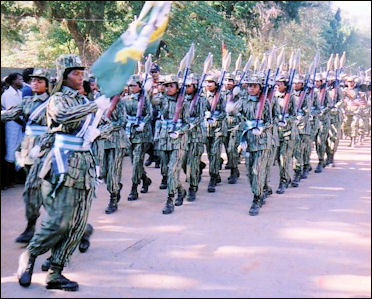
Women Tamil Tiger
fighters in Sri Lanka Karla Cunningham wrote in the Los Angeles Times: “Women are becoming more lethal. In jihadist organizations — including even Al Qaeda, which had long banned females from violent roles — women are increasingly taking part in terrorist actions. Since 1985, terrorism's so-called invisible women have accounted for a quarter of fatal attacks in Iraq, Egypt, Israel, Lebanon, Chechnya, Sri Lanka, Morocco and Palestine. My research found that by mid-2008, women had acted as suicide bombers 21 times in Iraq's markets and other civilian venues patronized by Shiites. Other research has demonstrated that since 2002 women have carried out fully 50 percent of suicide attacks in Sri Lanka, Turkey and Chechnya. [Source: Karla Cunningham, Los Angeles Times, April 4, 2012. Cunningham is a political scientist at the Rand Corp. She writes regularly on female terrorism.]
“So why do we think of violent jihadists as largely male? One reason is that terrorism observers, mostly men who have historically focused on men at war, tend to view women who participate in acts of terrorism as exceptions. Given women's increasingly violent roles in jihadist organizations, however, researchers overlook females as effective killers at our peril. Chechen women have been so successful as terrorists that Chechen leadership has now shifted to using them more than men. The Sri Lankan terrorist organization Liberation Tigers of Tamil Eelam managed to kill India's prime minister in a one-on-one suicide attack because a female terrorist was able to get close to him where a male terrorist might have had more difficulty.
“The increasing participation in violence by female jihadists represents, in part, a generational shift in their attitudes toward violence. In the past, these women seldom went beyond such activities as gun-running, harboring fugitives, fund-raising and intelligence — activities that oiled the terrorist machine and enabled it to operate smoothly but kept women at a remove from violence. Now many are no longer content to sit on the sidelines. In 2008, Ayman Zawahiri, then second in command of Al Qaeda, allowed no female bombers in Al Qaeda. He told female supporters their role was to stay home and raise children. But then the next year his wife, Omaima Hassan, defied him and went online to encourage women to become more active in jihad.
“Part of the reason male jihadists have accepted more female participation is that terrorist organizations have lost many men through counter-terrorism. As women have volunteered to become suicide bombers, they proved to be highly successful in hiding their bombs — and their intent to use them — under religious clothing. They raise fewer suspicions, and male jihadists appreciate that women can take advantage of the lack of female security personnel and gender-biased enforcement to get closer to their targets. For their part, a younger generation of female jihadists has come to believe that acts of violence can be just as liberating politically and spiritually for women as for men. A religious woman can deflect her parents' or husband's objections by invoking the name of religion, which trumps all. The new mantra is "even women must fight."
“The women-as-terrorist trend is highly likely to continue. Al Qaeda recently launched an Arabic-language magazine targeting women — much as its English-language magazine, Inspire, targets men — and urging them to take up the jihadist mantle. In their writings for the magazine, women also attempt to shame men for not being active enough.
Female Suicide Bombers in Israel

Poster glorifying female suicide bomber in Gaza On January 27, 2002, Wafa Idrees, the first female bomber to strike inside Israel, killed one person, an elderly Jewish man, in an attack. Compared with Joan of Arc in the Palestinian territories, she was an ambulance worker, reportedly motivated by the carnage she witnessed at the hands of the Israelis. After her death. Her face was all over the territories: on widely circulated posters, on television, and in the international press. A week or so earlier a member of Arafat’s Fatah group shot up the bat mitzvah of a 12-year-old girl, killing six.
On March 27, 2002, a Hamas suicide bomber disguised with a wig as a woman entered the Park Hotel in Netanya and blew himself up in the middle of 250 Israelis who just sat down for Passover dinner. A total of 28 people were killed and 150 were injured. Television images of the bombing on television showed splattered blood and bodies among prayer books and place settings. The attack, which became known as the Passover massacre, was the deadliest of the Second Intifada.
Two days later a 17-year-old Palestinian girl scheduled to be married the next summer, blew herself up at a Jerusalem supermarket, killing two bystanders and injuring 19 others. The next day a suicide bomber, belonging to a militia with links to Arafat’s Fatah movement, blew himself up in Tel Aviv, injured 32 people, the day after that a Hamas suicide bomber blew himself up in Haifa, killing 14 people.
Not long after this three 14-year-old boys, who were regarded as the smartest kids in their 8th grade class, made a pipe bomb armed themselves with knives and tried to tunnel under a fence of Gaza Strip Jewish settlement. They were spotted by Israeli guards and shot and killed. Afterwards there was widespread condemnation of suicide bombing as tactic. Even Hamas came out and said that children should not become suicide bombers.
Burqa Bombs

burqas Sometimes women dressed in burqas are used in suicide attacks in Pakistan and Afghanistan. It is easy to hide a bomb in a loose-fitting burqa plus it is hard to search burqa-clad attackers in conservative tribal society. Reporting on a burqa attacks in Pakistan in December 2010, Zeeshan Haider of Reuters wrote: A woman covered in a head-to-foot burqa carried out a suicide bombing that killed more than 40 people in Pakistan, government officials said. The woman blew herself amid a crowd of men, women and children heading toward a food distribution center of the World Food Program in the Bajaur region on the Afghan border. "Initially there was confusion as to whether the attacker was a man or woman but now we have established that (it) was a woman," senior government official Sohail Ahmed told Reuters. Government officials in Bajaur said they had recovered the head, burqa and clothes of the bomber. It was the second such attack by a female militant in Pakistan. In the first episode, a woman detonated explosives near a military checkpost in the northwestern city of Peshawar in 2007, but she killed no one except herself.[Source: Zeeshan Haider, Reuters, December 26, 2010]
The woman in the 2010 attack initially threw hand grenades at people heading toward the food center to receive aid before blowing herself up. Forty-three people were killed and more than 60 were wounded in the attack. "If militants use more women for such attacks then it is going to be a very huge problem for the security forces," said Rahimullah Yusufzai, an expert on tribal and militant affairs. "They don't have enough women (in the) police force and even (if) they have policewomen, because of our conservative culture, people don't want their women to be subjected to body searches. It's going to be a big problem."
Saturday's attack targeted members of Salarzai, a major pro-government tribe backing army offensives against militants. Salarzai tribesmen have been a key role in mobilizing lashkars, or tribal militia, to back government military operations. A Taliban spokesman, Azam Tariq, claimed responsibility for the suicide bombing, saying that it was retaliation for "Salarzai activities against the Taliban."
Sometimes the burqa bombers are men. In June 2012 Reuters reported: “A suicide bomber dressed in a burqa blew himself up near a French patrol in Afghanistan, killing four soldiers and wounding five as the Taliban step up a spring offensive. The attack - one of the deadliest on the French contingent in months - occurred in the mountainous Kapisa province in the east of the country, an area mainly patrolled by a French force under NATO command. "It was an unfortunate incident. There was a patrol of coalition soldiers in a small bazaar and they were attacked by a suicide bomber wearing a burqa," Afghan Interior Ministry spokesman Sediq Sediqqi told Reuters. [Source: Sanjeev Miglani, Reuters, June 9, 2011]
Body Bombs
In July 2011 Associated Press reported: “Airlines are being warned by the government that terrorists are considering surgically hiding bombs inside humans to evade airport security. As a result, travelers may find themselves subjected to more scrutiny when flying in the heart of summer vacation season, especially to the U.S. from abroad. The FBI and Homeland Security Department sent a memo to security officials around the country on Wednesday about "body packing," describing it as a "criminal tactic with possible terrorist application." [Source: Eileen Sullivan, Associated Press, July 6, 2011]
The memo, obtained by The Associated Press, cited a 2005 incident in which Colombian men were accused of surgically implanting narcotics into human couriers. The memo offered possible indicators of surgically implanted contraband, including a distended stomach or other unusual bulging, and visible physical discomfort from a pat-down.

Pregnancy prosthetics could be used by suicide bomber
Bombs-in-the-body is not a new idea, but recent intelligence indicates a fresh interest in using this method. People-scanning machines in airports aren't able to detect explosives hidden inside humans. Still, there is no current information that points to a specific plot involving surgically implanted explosives, a U.S. security official said.
In 2010 it was reported that British officials uncovered intelligence that al-Qaida was seeking to surgically implant bombs inside people, a move some believed was prompted by the use of full-body imaging machines at major airports around the world. Once a terrorist finds a willing suicide bomber, secures the explosive material and makes the bomb, carrying off this tactic is not that difficult, said Chris Ronay, a former chief of the FBI explosives unit. "It's rather easy and the damage could be rather severe," Ronay said.
Surgery to implant explosives could be done a couple of days before a planned attack, said James Crippin, an explosives expert in Colorado. In order for it to work, there would need to be a detonation device, and it's conceivable that if the explosive was implanted in a woman's breast, the detonator could be underneath the breast so that all the operative would have to do is press downward, Crippin said.
But Jimmie C. Oxley, a chemistry professor at the University of Rhode Island and explosives expert, said it would be tough to carry out such an effort successfully. She said there are only so many places to hide a bomb in the body, and a suicide bomber would have to recover enough from the surgery to travel and set off the device.
Efforts to Stop of Suicide Terrorism
The Economist reported: How can the targets of such attacks protect themselves? By picking on democracies, the terrorists can be reasonably sure that their adversaries will stop short of “the Mongol method” (ie, wholesale slaughter of the population from which the bombers derive). Even so, suicide campaigns are often designed to madden their victims into inflicting collective punishment, thus further radicalising the terrorists' actual or potential supporters, who might otherwise be repulsed by the carnage that such extreme violence causes. [Source: The Economist, January 8, 2004]

Israeli cartoon
“But there are subtler methods. Because they are corporate enterprises, disrupting or preventing attacks is not just a question of catching the bomber: there are also recruiters, trainers, reconnaissance agents, bomb-makers and safe houses. Israel prevents many attacks by penetrating these networks — though as Shlomo Gazit, a former head of military intelligence, points out, Israel knows roughly where its enemies can be found, and so can monitor their movements and cultivate informers. Police in, say, London or New York do not enjoy that luxury.
“Israel's checkpoints and cordons (also unlikely to be emulated elsewhere) intercept some killers; they also reassure the public that something is being done, thus countering the terrorists psychologically as well as militarily. Even when the bomber gets through, vigilant security guards who manage to keep pedestrian attackers out of restaurants or discotheques can massively reduce the number of casualties. Other sensible defensive measures include the rapid dispersal of crowds at the scene of an explosion, to protect them from follow-up strikes. Such vigilance can make life grindingly tense. If possible, the best answer must be to choke the supply of the terrorists' prize asset — the bombers — through political compromise. Yet against the ultra-extremists of al-Qaeda, intelligence, disruption and vigilance may be the only ways.
Image Sources: Wikimedia Commons, Israel Defense Forces
Text Sources: New York Times, Washington Post, Los Angeles Times, Times of London, The Guardian, National Geographic, The New Yorker, Time, Newsweek, Reuters, AP, AFP, Wall Street Journal, The Atlantic Monthly, The Economist, Global Viewpoint (Christian Science Monitor), Foreign Policy, Wikipedia, BBC, CNN, NBC News, Fox News and various books and other publications.
Last updated July 2012
